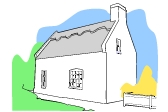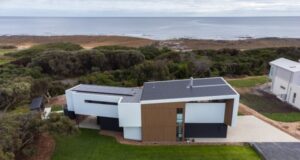
A gabled roof, often called a ‘pitched roof’ or a ‘peaked roof’, is easily recognised from its triangular shape. Gabled roofs also offer a greater amount of room for an attic.

What is a gabled roof?
A true gabled roof can be recognised by the symmetrical triangular shape created at the top of the building by the two roof panels. These two panels should be pitched so they meet in the centre of the building in a ridge. The gabled roof’s sloping shape makes it popular in regions which receive heavy snowfalls – the steeper the slope, the more easily the snow will slide off.
Although gabled roofs are functional, cheap, easy to construct, and allow for more interior space (relative to other roofing types), they tend to be more steeply pitched than other roof types. Steeply pitched roofs don’t mix well with strong winds. This feature, along with our general lack of snowfall, makes the gabled roof less popular in Australia than in other parts of the world – although it is still widely used throughout Australia.
What types of gabled roofs are there?
Different types of gabled roofs exist to accommodate a variety of different needs and tastes. Some of these are listed below:
- Crow stepped gable – This roof has step-shaped ends, a feature which originated in order to help give construction workers, repairmen and chimney sweeps access to roofs which were often steep and very hard to climb. Crow stepped roofs can be more prone to water leakage than plain gabled roofs, because there tends to be a gap between the roof and the stepped ends.
- Dutch gable – A Dutch gable is similar to the crow stepped gable, in that its ends are not straight. The Dutch gable has ornately curved sides which, unlike the crow stepped edges, are purely for decorative purposes. The Dutch gable often suffers the same problems with leakage as the crow stepped gable.
- Saltbox gable – This describes a non-symmetrical gabled roof, where the two roof panels are differently pitched.
- Boxed gable – A boxed gable roof has eaves which extend over all of the walls of the house.
- Jerkinhead gable – The jerkinhead gable has a flattened peak, which may also be angled to face down towards the front of the building.
- Gambrel roof – A gambrel roof is a symmetrical gable-style roof with two slopes on each side, rather than one.
What materials are used?
Gabled roofs can be constructed out of most materials, including metal and terracotta or concrete tiles. Some materials are more effective at encouraging snow and ice to slip off though. A gable roof that has been built to include hips and valleys should be shingled to prevent water leakage.
|
Advantages
|
Disadvantages
|





